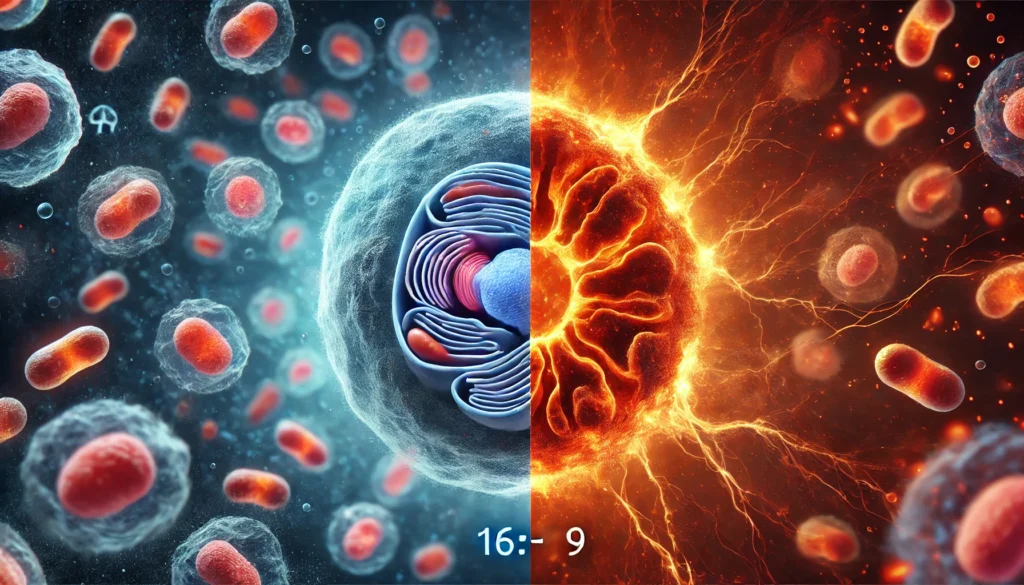Introduction
The human body operates with a remarkable level of precision, adapting to changing environments, stressors, and internal cues. One of the most critical but often misunderstood physiological processes is metabolism—the mechanism by which our bodies convert food into energy. While much attention is given to sluggish or low metabolism, there exists a lesser-known but clinically significant counterpart: hypermetabolism. This accelerated state of metabolic activity can have profound implications on health, energy balance, and disease progression.
You may also like: Do Carbs Cause Brain Fog? What Science Reveals About Carbohydrates and Mental Clarity
Hypermetabolism is not merely about burning calories at a faster rate. It involves a systemic increase in energy expenditure, often resulting in a cascade of physiological effects that can be both beneficial in short-term adaptive scenarios and damaging when chronic or associated with underlying medical conditions. Hypermetabolism symptoms may include rapid weight loss, increased heart rate, fatigue, heat intolerance, and persistent hunger. In more severe cases, it reflects a hypermetabolic state in which the body is consuming its own resources at an unsustainable rate, leading to organ stress and nutritional depletion.
Understanding the causes and consequences of this condition is crucial for patients, caregivers, and healthcare providers alike. Hypermetabolism is often seen in the context of serious illnesses such as cancer, burns, sepsis, traumatic brain injury, and hyperthyroidism. It may also arise in response to intense physical trauma or chronic inflammation. When left unrecognized or untreated, the hypermetabolic state can exacerbate disease outcomes, complicate recovery, and contribute to muscle wasting, immune dysfunction, and impaired healing.
This article explores hypermetabolism through a deeply scientific lens, examining the physiological mechanisms, diagnostic challenges, and evolving treatment approaches. By dissecting the nuanced spectrum of hypermetabolism symptoms and how they relate to the hypermetabolic state, we aim to provide a comprehensive guide grounded in evidence and clinical experience. Whether you’re managing a chronic illness, recovering from acute trauma, or navigating unexplained metabolic changes, understanding hypermetabolism may hold the key to unlocking better outcomes and renewed vitality.

What Is a Hypermetabolic State?
The hypermetabolic state is defined as a condition in which the body’s basal metabolic rate (BMR) is significantly elevated above normal resting levels. This increase in metabolic activity leads to an accelerated breakdown of macronutrients—primarily fats, carbohydrates, and proteins—to meet the heightened energy demands. While the body typically burns energy to maintain essential functions like breathing, circulation, and thermoregulation, in a hypermetabolic state, this energy burn becomes excessive and unsustainable.
At the cellular level, the mitochondria—the energy powerhouses of cells—become hyperactive, producing more ATP (adenosine triphosphate), which fuels cellular processes. However, this increase in energy production comes with a cost. Excessive metabolic activity generates higher levels of reactive oxygen species (ROS), which can contribute to oxidative stress, cellular damage, and inflammation.
The hypermetabolic state can manifest acutely in response to injury or illness, such as severe burns or systemic infection. In these cases, the body mobilizes its energy reserves to fuel the repair process. Alternatively, chronic hypermetabolism can occur due to hormonal imbalances, malignancies, or autoimmune conditions. One of the hallmark signs of this state is unintended weight loss despite adequate or increased caloric intake—a consequence of the body’s increased energy demands outpacing nutritional supply.
Hypermetabolism differs from simply having a “fast metabolism.” A fast metabolism often reflects a healthy physiological variation. In contrast, a hypermetabolic state represents a pathological acceleration that can deplete the body’s energy stores, weaken immunity, and impair organ function. Understanding the drivers and implications of this state is vital for accurate diagnosis and effective treatment.

Common Hypermetabolism Symptoms and Clinical Presentation
Recognizing hypermetabolism symptoms requires a nuanced understanding of how the condition affects multiple organ systems. These symptoms can vary based on the underlying cause, duration of the hypermetabolic state, and the individual’s baseline health status. However, several hallmark features are consistently observed across clinical settings.
One of the most prominent hypermetabolism symptoms is unintended weight loss. This occurs even when the individual maintains a normal or increased calorie intake. The accelerated breakdown of macronutrients—especially protein from muscle tissue—leads to muscle wasting and a visible reduction in lean body mass. This catabolic process not only affects physical appearance but also compromises strength, mobility, and immune function.
Increased heart rate (tachycardia) is another common symptom, reflecting the body’s attempt to meet increased metabolic demands through enhanced circulation. Patients may also experience elevated respiratory rate, warm or flushed skin, and excessive sweating due to thermoregulatory changes. These signs can be mistaken for fever or anxiety, complicating diagnosis.
Fatigue and heat intolerance are also prevalent. As the body expends more energy at rest, individuals often feel drained, even without significant physical exertion. Heat intolerance arises because of increased internal heat production and impaired ability to dissipate it effectively.
Additional hypermetabolism symptoms may include persistent hunger, insomnia, restlessness, and hormonal irregularities. Women may notice changes in menstrual cycles, while men may experience reduced libido or testosterone levels. In children, hypermetabolism can result in poor growth and delayed developmental milestones.
These symptoms collectively point to an internal state of overdrive, where the body’s systems are pushed beyond their natural equilibrium. Identifying these signs early is crucial, as prolonged hypermetabolic states can lead to serious complications if not addressed in a timely and targeted manner.

Causes and Conditions Linked to Hypermetabolism
The hypermetabolic state does not arise in isolation. It is often triggered or sustained by a variety of medical conditions, each involving unique pathways but converging on the same outcome: increased metabolic demand. Understanding the root causes is essential for tailoring treatment and preventing long-term damage.
One of the most well-documented causes of hypermetabolism is severe burns. In response to extensive skin damage, the body dramatically increases its metabolic activity to fuel the healing process. This results in an elevated BMR that can persist for weeks or months, depending on the severity of the injury. Patients in burn units often require double or triple their normal caloric intake just to maintain weight and support recovery.
Cancer is another major contributor to a hypermetabolic state, particularly in advanced stages or aggressive malignancies. Tumor cells consume large amounts of glucose and amino acids, creating a metabolic competition between cancerous tissues and healthy cells. This phenomenon, known as the Warburg effect, plays a key role in cancer-associated cachexia—a wasting syndrome characterized by weight loss, muscle depletion, and fatigue.
Hyperthyroidism, especially Graves’ disease, also induces hypermetabolism. Excess thyroid hormone stimulates almost every tissue in the body to produce more energy, leading to the classic hypermetabolism symptoms of weight loss, anxiety, tremors, and heat intolerance.
Infectious diseases, such as sepsis, activate the immune system and inflammatory pathways, increasing metabolic demands. Similarly, chronic inflammatory conditions like rheumatoid arthritis and inflammatory bowel disease may induce low-grade hypermetabolism that exacerbates fatigue and nutrient deficiencies.
Neurological trauma, including traumatic brain injury (TBI), is another context in which hypermetabolism is frequently observed. The injured brain often enters a hypermetabolic state as it attempts to repair damage and restore function. This energy demand may outstrip the body’s ability to supply fuel, particularly if nutritional support is inadequate.
In rare cases, genetic or mitochondrial disorders can produce a chronic hypermetabolic profile, usually detected in early childhood. These cases often involve complex diagnostic challenges and require specialized metabolic management.
Understanding these diverse triggers reinforces the need for a comprehensive, individualized approach to identifying and managing hypermetabolism.
Diagnosing a Hypermetabolic State
The diagnostic process for identifying a hypermetabolic state involves a combination of clinical evaluation, laboratory testing, and imaging studies. The goal is to confirm the presence of elevated metabolic activity while also identifying any underlying causes that may be driving the condition.
One of the most direct methods of assessing metabolic rate is indirect calorimetry, a test that measures oxygen consumption (VO2) and carbon dioxide production (VCO2). From these values, clinicians can calculate the patient’s resting energy expenditure (REE), which is compared to predicted norms. A significantly elevated REE suggests a hypermetabolic state and helps determine nutritional needs.
Laboratory markers can also provide valuable insights. Elevated thyroid hormones (T3 and T4) with suppressed TSH (thyroid-stimulating hormone) point to hyperthyroidism. Inflammatory markers such as C-reactive protein (CRP), interleukin-6 (IL-6), and tumor necrosis factor-alpha (TNF-α) may indicate ongoing systemic inflammation.
Complete blood count (CBC), metabolic panels, and liver function tests help evaluate organ stress and rule out anemia or electrolyte imbalances that may exacerbate symptoms. Elevated fasting glucose, insulin, or lactate levels may also suggest altered energy metabolism.
Body composition analysis using dual-energy X-ray absorptiometry (DEXA) or bioelectrical impedance can detect loss of lean muscle mass, a hallmark feature of hypermetabolism.
Imaging studies such as PET scans can highlight areas of increased metabolic activity, especially in cases involving malignancy or infection. In neurological cases, brain MRI or functional imaging may detect changes consistent with trauma-induced hypermetabolism.
Diagnosing hypermetabolism requires careful synthesis of clinical signs and diagnostic findings. It’s not enough to rely on weight loss alone—contextualizing the full spectrum of hypermetabolism symptoms and lab evidence is essential for developing an effective treatment plan.

Nutritional Strategies to Manage Hypermetabolism
Nutritional support plays a foundational role in managing hypermetabolism. Because the body is burning calories at an accelerated rate, failure to meet these demands can lead to rapid deterioration of muscle mass, immune function, and wound healing capacity. A personalized, dynamic approach to nutrition is therefore critical.
Caloric intake must be adjusted to match or exceed the elevated energy expenditure measured by indirect calorimetry or estimated by predictive equations. In burn patients, for example, energy needs may be 1.5 to 2 times the normal requirement. In cancer cachexia, protein and energy needs are also significantly elevated.
Protein intake is especially important, as hypermetabolism increases protein catabolism. Recommendations often range from 1.5 to 2.5 grams of protein per kilogram of body weight per day, depending on the severity of muscle wasting and the individual’s tolerance.
High-fat, high-protein diets may be preferable in some cases, as they offer calorically dense options for individuals struggling with appetite loss or digestive issues. Nutritional formulas designed for hypermetabolic states may also include omega-3 fatty acids, which have anti-inflammatory properties and may help preserve muscle mass.
Micronutrients like zinc, vitamin C, selenium, and B vitamins are essential for wound healing, immune support, and mitochondrial function. In some scenarios, supplementation is required to meet these elevated needs.
For patients unable to eat sufficient food orally, enteral or parenteral nutrition may be necessary. Early initiation of nutritional support in hospitalized patients with hypermetabolism is associated with improved outcomes, faster recovery, and reduced complication rates.
Dietitians play a pivotal role in monitoring nutrient intake, adjusting macronutrient ratios, and supporting adherence to dietary plans. Consistent reassessment is crucial, as energy demands may fluctuate during recovery or in response to treatment.
Medical Treatment and Pharmacologic Interventions
Treating the hypermetabolic state often requires addressing the underlying condition while simultaneously managing its systemic effects. In many cases, pharmacologic intervention is necessary to modulate hormonal imbalances, inflammation, or catabolic processes.
In patients with hyperthyroidism, medications such as methimazole or propylthiouracil (PTU) can reduce thyroid hormone production and mitigate hypermetabolism symptoms. Beta-blockers are frequently used to control heart rate and reduce anxiety-like symptoms associated with increased sympathetic activity.
In cancer-related hypermetabolism, treatment of the tumor is paramount. Chemotherapy, radiation, or immunotherapy may reduce the metabolic demand by shrinking tumor mass. Adjunct therapies like corticosteroids or megestrol acetate may help stimulate appetite and reduce inflammation in cachectic patients.
Anti-inflammatory agents may be used in cases where cytokine overexpression contributes to the hypermetabolic response. Drugs targeting IL-6 or TNF-α pathways have shown promise in reducing catabolic processes and improving metabolic balance.
In trauma or burn patients, anabolic agents like oxandrolone have been used to preserve lean muscle mass and reduce nitrogen loss. Insulin therapy, when carefully managed, may improve glucose utilization and reduce protein catabolism in critical illness.
Nutraceuticals, including branched-chain amino acids (BCAAs), creatine, and carnitine, may support energy production and muscle preservation, although more research is needed to validate their efficacy in hypermetabolic populations.
Ultimately, pharmacologic management should be individualized based on the patient’s underlying diagnosis, symptom profile, and treatment goals. Multidisciplinary collaboration among physicians, dietitians, physical therapists, and mental health professionals is essential for optimal outcomes.
The Role of Exercise in Hypermetabolic Recovery
While rest is essential during acute phases of illness or injury, exercise can be a powerful tool in mitigating the adverse effects of prolonged hypermetabolism. The key is to apply exercise judiciously, based on the individual’s capacity and recovery phase.
Resistance training helps counteract the muscle loss that accompanies hypermetabolic states. Even minimal strength training can stimulate muscle protein synthesis, enhance mitochondrial efficiency, and support functional independence.
Low-intensity aerobic exercise, such as walking or stationary cycling, can improve cardiovascular fitness, circulation, and mood without overstressing the system. For individuals recovering from cancer, burns, or neurological injuries, exercise may also reduce inflammation and improve insulin sensitivity.
Exercise also promotes hormonal balance, helping normalize cortisol, testosterone, and growth hormone levels—many of which are dysregulated during prolonged stress or illness.
Supervision by a physical therapist or exercise physiologist is essential in early recovery stages to avoid overexertion, joint strain, or cardiovascular instability. As strength and stamina improve, exercise programs can be intensified to match the individual’s goals and metabolic capacity.
Engaging in regular movement, however modest, contributes significantly to recovery and enhances long-term metabolic health.
Psychological Effects of Living in a Hypermetabolic State
Chronic hypermetabolism does not only affect the body—it impacts the mind. Individuals experiencing prolonged hypermetabolism symptoms often report anxiety, irritability, mood swings, and depression. These psychological effects may be driven by hormonal imbalances, nutrient deficiencies, or the exhausting experience of constantly feeling unwell despite rest and nutrition.
Sleep disturbances are common, partly due to elevated sympathetic nervous system activity. Restlessness and insomnia contribute to a vicious cycle of fatigue, reduced appetite, and worsening catabolism. Addressing sleep hygiene and considering targeted therapies such as melatonin or cognitive behavioral therapy for insomnia (CBT-I) can improve outcomes.
Chronic illness also takes an emotional toll. Patients with cancer, burns, or neurological injuries may experience grief, frustration, or loss of identity as their bodies and abilities change. Integrating mental health support into treatment plans is crucial, whether through counseling, support groups, or psychiatric care.
Caregivers, too, may experience psychological stress as they manage complex nutritional and medical needs. Including them in care discussions and offering resources for support is part of holistic care.
Addressing the emotional and psychological dimensions of hypermetabolism enhances treatment compliance, improves quality of life, and fosters resilience during recovery.
Frequently Asked Questions
1. What is the difference between a fast metabolism and a hypermetabolic state?
A fast metabolism typically refers to a normal physiological variation where an individual burns calories more efficiently at rest and during activity. It often results in a lean body composition and higher energy needs but does not cause adverse symptoms. In contrast, a hypermetabolic state is a medical condition characterized by excessive and often harmful increases in energy expenditure. It is usually associated with illness, injury, or hormonal imbalance and often presents with symptoms like rapid weight loss, fatigue, and muscle wasting.
2. What are the early signs of hypermetabolism?
Early signs of hypermetabolism include unexplained weight loss, increased appetite, rapid heartbeat, restlessness, and fatigue despite adequate rest. Individuals may also experience persistent feelings of warmth, sweating, and anxiety. Over time, symptoms can progress to muscle loss, insomnia, and weakened immune function. Identifying these early signs can help initiate timely diagnostics and supportive interventions.
3. Can hypermetabolism occur without a medical condition?
While hypermetabolism is most commonly associated with medical conditions such as burns, cancer, or hyperthyroidism, it can occasionally occur in otherwise healthy individuals during periods of intense physical stress or overtraining. However, in these cases, the symptoms are usually transient and resolve with rest and nutritional support. Persistent or severe symptoms should prompt medical evaluation.
4. How is a hypermetabolic state diagnosed?
A hypermetabolic state is diagnosed through a combination of clinical observation, metabolic testing (such as indirect calorimetry), blood work, and imaging studies. Indirect calorimetry measures oxygen use and carbon dioxide production to estimate energy expenditure. Elevated resting energy expenditure relative to predicted norms confirms hypermetabolism. Additional tests help identify underlying causes, such as thyroid function tests, inflammatory markers, and body composition scans.
5. What dietary changes are needed to manage hypermetabolism?
Managing hypermetabolism requires increased caloric and protein intake to match elevated energy demands and prevent muscle wasting. High-protein, high-fat diets may be recommended for patients with appetite loss or difficulty eating. Micronutrient support is also essential, with a focus on zinc, selenium, vitamin C, B vitamins, and omega-3 fatty acids. Nutrition plans must be tailored and monitored frequently by a healthcare provider or dietitian to ensure efficacy and safety.
6. Are there medications that can slow down hypermetabolism?
Yes, several medications can help reduce hypermetabolic activity depending on the underlying cause. Antithyroid drugs like methimazole can reduce thyroid hormone levels in hyperthyroidism. Beta-blockers may help reduce heart rate and anxiety symptoms. Anti-inflammatory agents and anabolic steroids may also be used in certain cases to slow muscle breakdown and support recovery. Treatment must always be guided by a physician based on the root cause of the condition.
7. Is hypermetabolism dangerous if left untreated?
Yes, untreated hypermetabolism can lead to serious complications such as malnutrition, muscle wasting, organ dysfunction, and weakened immunity. In severe cases, it may contribute to cachexia—a life-threatening wasting syndrome. Early detection and comprehensive management are critical to improving outcomes and preventing irreversible damage.
8. Can hypermetabolism affect children?
Children can experience hypermetabolism, especially in response to burns, trauma, or genetic metabolic disorders. In pediatric cases, hypermetabolism may impair growth, cause developmental delays, and increase vulnerability to infections. Children may require specialized nutritional and medical support to manage these effects and support healthy development.
9. How long does it take to recover from a hypermetabolic state?
Recovery from hypermetabolism varies widely depending on the underlying cause, the severity of symptoms, and the individual’s overall health. Some cases resolve within weeks with appropriate treatment, while others—especially those linked to chronic illness—may persist for months or require lifelong management. Consistent medical supervision, nutritional therapy, and physical rehabilitation are key to sustained recovery.
10. What role does inflammation play in hypermetabolism?
Inflammation is a central driver of hypermetabolism in many conditions, particularly in critical illness, cancer, and autoimmune diseases. Inflammatory cytokines like IL-6 and TNF-α increase metabolic rate and stimulate protein breakdown. Managing inflammation through medication, diet, and stress reduction is a cornerstone of hypermetabolic treatment and recovery.

Conclusion
Hypermetabolism is a complex, multifaceted condition that can profoundly affect every aspect of physical and mental health. Recognizing the signs early—such as unintended weight loss, fatigue, increased heart rate, and thermoregulation issues—can lead to timely diagnosis and improved outcomes. The hypermetabolic state represents a physiological overdrive that, if left unchecked, depletes the body’s reserves and accelerates decline, especially in vulnerable individuals.
From the underlying mechanisms of mitochondrial overactivity to the systemic impact of inflammatory cytokines and hormonal imbalances, the science of hypermetabolism underscores the importance of integrated care. Nutritional support, targeted medical treatment, exercise rehabilitation, and psychological counseling must work in concert to address both the symptoms and the root causes of this condition.
Whether the hypermetabolism is triggered by trauma, illness, or chronic inflammation, proactive intervention can make a significant difference. Health professionals, caregivers, and patients must collaborate to personalize care, monitor changes, and respond dynamically to evolving metabolic needs.
In the journey toward recovery, understanding the body’s metabolic rhythms and respecting their signals is key. Hypermetabolism, when properly managed, need not be a life sentence. Instead, it can be a signal—one that, with the right support, can lead to deeper healing, strength, and resilience.
Was this article helpful? Don’t let it stop with you. Share it right now with someone who needs to see it—whether it’s a friend, a colleague, or your whole network. And if staying ahead on this topic matters to you, subscribe to this publication for the most up-to-date information. You’ll get the latest insights delivered straight to you—no searching, no missing out.
Further Reading:
Metabolic Confusion Diet Plan: How to Boost Fat Loss With Science
How to Increase Metabolism: Scientific Ways to Boost BMR and Burn More Energy



